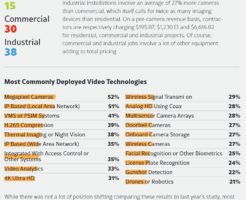2020 Video Surveillance Deep Dive: Prices, Profits, Challenges & More
Installing dealers/integrators report an average gross profit margin of 37.5% for their video surveillance projects — almost 5 points higher than in 2019.

Smile, you’re likely on camera! That’s right, if you’re not ready for your close-up, you’d had better join a certain castaway and his pal Wilson on their desert island (even then, nowadays, your image might be captured via satellite).
With deference to Alan Funt of TV’s classic, “Candid Camera,” and Tom Hanks of the hit movie, “Cast Away,” from smartphone calls to online chats to business conferencing to mobile entertainment to POS advertising, video has come to infiltrate virtually every aspect of our lives.
That includes surveillance, where CCTV cameras and technology have proliferated to the extent where they’ve become synonymous with security — and increasingly overall facility and operational management too. Add to that a nonstop cavalcade of technological breakthroughs, enhancements and refinements, ranging from multisensor arrays to Cloud storage to edge processing to analytics to thermal imaging and well beyond.
The latter is particularly topical amid the COVID-19 crisis and the critical need to track temperatures. The pandemic figures to also add momentum to the already prevalent trend of tightly integrating access control solutions with video.
In totality, in concert with steadily declining costs and swiftly emerging application use cases, video surveillance represents one of the world’s most robust market opportunities. And no one is in a better position to capitalize than installing security dealers and systems integrators.
However, in an open, competitive field that will prove truer for some than others. The greatest degree of success is predicated on key factors like leadership, management, marketing, talent, agility, efficiency, training, customer service, vendor partners, etc.
Moreover, much in the same way algorithmic intelligence can be applied to optimize the value and usefulness of a surveillance system, so too can market knowledge provide installing security companies with a winning edge. A primary source for that arrives courtesy of Security Sales & Integration’s 2020 Video Surveillance Deep Dive.
The second such study of its kind, this new research was conducted during April and included more than 300 dealers and integrators from throughout the United States and Canada. In addition to the balanced geographical footprint, the study also drew respondents from a wide range of company sizes and years in business (see below for more demographic info).
As well it spanned the residential, commercial and industrial video surveillance sectors — including projects, prices, margins, verticals, challenges, technologies and more.
Among the highlights: installers are averaging $58K (residential), $817K (commercial) and $4.6M (industrial) per month on video projects; deploying 15 (residential), 30 (commercial) and 38 (industrial) cameras per job; including megapixel cameras 52% of the time; 76% are offering Cloud-based video surveillance as a service (VSaaS); residential, healthcare/education and offices are the leading vertical markets; and cybersecurity and end-user expectations are the top surveillance market hurdles.
Continue on as the following graphs, lists and sidebars depict the full story of a sizzling hot market that, if you play your cards right, just might fund your family’s future for generations to come.
View the 2020 SSI Video Surveillance Deep Dive Results
DEEP DIVE DEMOGRAPHICS
YEARS IN BUSINESS
A full range of newer and more veteran dealer and integrator companies were represented within the survey universe. Around half have been in business 15 years or less, and the average came in at 17.6 years.
NUMBER OF EMPLOYEES
The study encompassed a wide scope of installing video surveillance system company sizes. The sampling shows how small players continue to thrive as 26% have 10 or fewer employees on payroll. The average was 44.
GEOGRAPHIC FOOTPRINT
The Deep Dive survey group represents a balanced U.S. footprint, although the Northeast checked in 10 percentage points higher than any other region. A fifth of respondents conduct business nationwide and/or in Canada.
If you enjoyed this article and want to receive more valuable industry content like this, click here to sign up for our FREE digital newsletters!

Security Is Our Business, Too
For professionals who recommend, buy and install all types of electronic security equipment, a free subscription to Commercial Integrator + Security Sales & Integration is like having a consultant on call. You’ll find an ideal balance of technology and business coverage, with installation tips and techniques for products and updates on how to add to your bottom line.
A FREE subscription to the top resource for security and integration industry will prove to be invaluable.











interesting post, Thanks for sharing.
“deploying 15 (residential), 30 (commercial) and 38 (industrial) cameras per job” -The average amount of residential cameras per job is 8 or less. Imagine 15 cameras on a house.